Solar Eclipses Overview
Introduction
Solar eclipses
A solar eclipse occurs when the shadow cone of the Moon intersects the surface of the Earth and is observable by anyone within this shadow zone (see Figure 1).
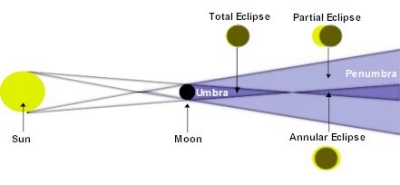 |
|
Figure 1: The type of eclipse that is observed depends on the position of the Earth in the Moon's shadow. |
Two conditions have to be met for a solar eclipse to occur. The first concerns the relationship between the orbits of the Earth and the Moon, which are not in the same plane, but are inclined at around 5 degrees (5° 8' 43") to each other. The Moon crosses the plane of the Earth's orbit twice in each complete lunar orbit. For an eclipse to occur the Moon must be near one of these intersection points, called nodes.
The second condition is that the Sun, the Earth and the Moon must also be lined up, corresponding to the phase of the New Moon.
Types of solar eclipses: annular, partial, total
The Moon's shadow consists of two cone-shaped areas (see Figure 1), known as the umbra (externally tangent to the Sun and Moon) and the penumbra (internally tangent to the Sun and Moon). For an observer standing between the Moon and the umbra cone summit the eclipse is total. If the observer is beyond the cone summit, the eclipse is annular (ring-like): the apparent diameter of the Moon is too small to mask the whole solar disk. For an observer standing in the penumbra, only a part of the Sun is masked: the eclipse is partial.
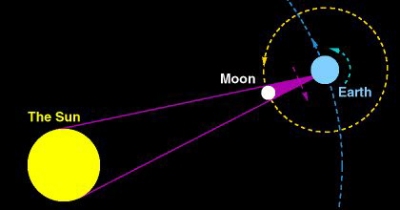 |
|
Figure 2: Why the eclipse goes west to east |
The most favourable conditions for a total eclipse are when the Moon is at its perigee, the Earth is farthest from the Sun (around July) and when the Sun is observed near zenith. When these conditions are all met, one can have a totality duration of more than 7 minutes.
Science of Eclipses
Historic Discoveries
The ancient Greeks and Romans used dated references to eclipses to improve the calendar. They also noted phenomena related to eclipses. The corona seen during eclipses was only identified as a solar phenomenon in the middle of the 19th century. Until then it was thought that the corona might come from terrestrial smoke, or that it indicated a lunar atmosphere. Kepler attributed it to solar light refracted by the atmosphere of the Moon. Even Halley (who predicted with success the path of the 1715 eclipse) and Arago interpreted the corona to be lunar in origin.
It was Cassini who established a link with the solar zodiacal light in 1683. The British amateur astronomer Francis Baily observed from the 1836 annular eclipse the irregularities of the lunar limb. The first successful total eclipse photograph was taken on July 1851 by Berkowski from Königsberg. At the 1860 eclipse, photographs obtained by W. De La Rue and A. Secchi from two sites 500 km apart showed that prominences could not belong to the Moon, but were in fact of solar origin.
From 1842, the use of spectroscopes allowed the recognition of helium emission as well as a new, unknown emission line measured by Janssen at the 1868 eclipse from India. This was shown later by Ramsey (in 1900) to come from an element then unknown on Earth and therefore given the name Helium - now measured as the second most abundant element in the Universe.
Coronal eclipse spectra taken in 1869 also showed mysterious green and yellow spectral lines first attributed to another unknown element given the name "Coronium". It was only much later, after the development of quantum mechanics and the measurement of spark discharge spectra by Bowen Edlen (1939), that the physicist Grotrian was able to solve the mystery of the coronium. Grotrian showed that these mysterious transitions in fact show iron in a very high state of ionisation due to the extreme temperature (iron having lost 9 electrons for the red coronal line and 13 electrons for the green coronal line) of the corona.
This can only occur at temperatures exceeding a million degrees. This discovery has led to another puzzle still unsolved today, but to which SOHO has unveiled fundamental clues: what heats the corona?
Another famous eclipse in 1919 allowed Arthur Eddington to confirm Einstein's prediction of general relativity space-time distortion in a gravity field.
An earlier German expedition to conduct this test in August 1914 failed when the team was taken prisoner in Russia before being able to perform the key experiment. In 1919, Eddington selected two sites of observation from Brazil and Principe Island. The eclipse pictures showed an offset in the positions of stars due to solar gravitational bending of light that confirmed Einstein's theory exactly.
What can be measured during solar eclipses?
Eclipses made it possible to determine with precision the shape of the Moon. Their study improved the prediction of ephemerides. Even today, a total solar eclipse still allows astrophysicists to make valuable scientific measurements, particularly when coordinated with measurements from observatories in space.
Solar eclipses enable scientists to measure accurately the diameter of the Sun and to search for variations in that diameter over long time scales. Geophysicists measure eclipse phenomena induced in the high terrestrial atmosphere.
Total solar eclipses allow the observation of structures of the solar corona that cannot usually be studied due to the higher normal luminosity of skylight during the day.
The structures in the corona are similar to patterns seen around a magnet. In fact sunspots were shown to be solar surface magnetic structures, which have their counterpart in the corona. The study of the solar corona gives us much information about the Sun's surface and its global variations. The morphology of the corona is changing due to the reorganisation of the surface magnetic field during the solar cycle, which can be seen in eclipse pictures taken at different epochs. The reanalysis of historical eclipse reports and documents could help to understand long term solar magnetic variations.
One can follow these magnetically confined structures deep into the interplanetary medium. Eclipses make it possible to diagnose the physical conditions of temperature (at more than 1 million degrees), densities and dynamics, both in the corona and at the base of the sources of the solar wind. The dynamic instabilities, the solar wind and environment pervade the whole solar system and interact with the Earth's magnetosphere.
Artificial eclipses and coronagraphs
Until the invention of the coronagraph in 1930, the rare glimpses from solar eclipses were the only opportunities to observe and study the solar corona.
French astrophysicist Bernard Lyot developed the coronagraph instrument which made it possible for the first time to occult the solar disk in order to study the inner corona (creating an artificial eclipse). This is still limited by the stray-light emitted by the daylight atmosphere and only works from clean and high altitude sites such as the Pic du Midi, Sacramento Peak and Hawaii observatories.
Used with additional filtering techniques to isolate specific emission this has given interesting results. Lyot made a spectacular movie using the Pic du Midi instrument showing giant prominences, arches and ejections of coronal mass. Unfortunately he died soon after a total solar eclipse expedition in Khartoum in 1952.
The solar corona from space
A revolution in the study of the corona came with the space age. In early sounding rocket experiments extreme-ultraviolet (EUV) and X-ray telescopes gave a view of the Sun very different from that previously seen in visible light.
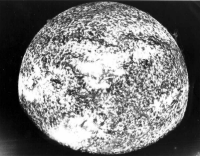 |
|
Figure 1. Lyman alpha UV photograph from sounding rockets (Bonnet 1979) |
X-ray radiation arises from high temperature coronal plasmas, and with these telescopes the corona can be mapped over the whole solar disk, and not only above the limb as in the eclipses. The X-ray and EUV instruments on the Skylab platform provided motion pictures of the solar corona, with the discovery of coronal holes of low X-ray emission, and changes in strongly emitting active magnetic regions. Also, space coronagraphs developed for the Solar Maximum Mission launched in 1982 mapped the outer corona in visible light, extending to long time scales the previously rare coronal snapshots obtained during eclipses.
The Yohkoh Japanese X-ray satellite, launched in 1991, has obtained millions of X-ray images of the dynamic solar corona. The ultimate observations of the solar corona are now being obtained with SOHO, the Solar Heliospheric Observatory. This includes data obtained with the Extreme UV Imaging Telescope (EIT), spectro-imagers (CDS, SUMER), a UV coronagraph (UVCS) measuring intensities and flows in the corona, and a three-channel visible coronagraph in the visible (LASCO) covering an impressive range of distances from 0.2 to 30 solar radii above the limb. In addition, experiments map the surface magnetic field (MDI) and in-situ particle detectors measure the solar wind and instabilities a million kilometres before they reach the Earth. SOHO now gives us a continuous view of the solar corona.
Coordinated eclipse-space observations
In this era of orbiting solar observatories, is there still a scientific benefit in making eclipse observations from Earth?
The biggest benefit comes from co-ordinating modern ground-based eclipse observations with space measurements. There are still new discoveries to be made from eclipses, by using the latest methods of investigation (very accurate timing, fast rate of measurements, wavelengths not covered from space such as infrared or visible ranges, new experimental techniques). The interpretation of eclipse data together with space data gives us new insights into earlier eclipse observations, and also allows the study of long-term historical variability of the solar corona, and of the solar magnetic cycle.
Since the launch of SOHO in 1995, co-ordinated campaigns have been conducted during the total solar eclipse of 26 February 1998, and the 11 August 1999 eclipse. SOHO measurements are analysed, together with ground based eclipse results, providing important insights into the nature of our Sun.
Eclipse Conditions
Solar and lunar eclipses are not independent. For both kinds of eclipse the Sun, Earth and Moon have to be aligned. If the lunar orbit plane did coincide with the ecliptic plane, there would be a lunar eclipse at each Full Moon and a solar eclipse at each New Moon. However, due to the inclination (5° 8' 43") of the Moon's orbit compared to that of the Earth, for an eclipse to occur the Moon has to pass through the plane of the Earth's orbit close to Full Moon, or close to New Moon. This happens about twice per year. Due to perturbations in the Moon's orbit the eclipse cycle is not exactly six months.
When these conditions are met, there can be a lunar eclipse and a solar eclipse within 15 days of each other. So, before the solar eclipse of 11 August 1999, there was a lunar eclipse of 28 July 1999.
A periodicity in the cycle of eclipses was noticed by ancient Greek astronomers. Its duration is 6585.32 days (or 18 years and 10.3 days), after which time the position of the Sun and the Moon, as viewed from the Earth, recur. This is known as the 'Saros cycle'. Within a given Saros cycle the eclipses succeed each other in almost identical manner, except that the observation position on Earth shifts by 120 degrees (0.32 days) from one eclipse to the next.
On average there are 42 solar eclipses (14 partial solar eclipses, 28 central solar eclipses) and 42 lunar eclipses (including 14 total lunar eclipses) per Saros cycle.
Geometry and timing of eclipses
For a total eclipse, the region of totality is a narrow band (up to 300 km wide) around the line of centrality. Outside the zone of totality (or annular eclipse) there exists a much more extended area (more than 7000 km) where the eclipse is partial. The shape of this area depends on the respective positions of the Earth, Moon and Sun. The amount of the Sun covered is greatest closest to the totality zone, and decreases symmetrically away from it.
The Moon's shadow sweeps across the Earth at high speed (more than 2500 km/h) from West to East. This determines the duration of the partial eclipse that can last as much as three hours, and of the total eclipse (from seconds to a few minutes) depending on the position of the observer.
The maximum duration of a total eclipse in the most favourable conditions corresponds to 7min 30s in equatorial regions and 6min 10s at the latitude of Paris.
Events during a total eclipse
A total eclipse is one of the most impressive natural phenomena. Before totality, the first phase of partial eclipsing of the solar disk takes some 40 minutes when the luminosity progressively drops to a few percent. The cooling of the local atmosphere is already noticeable.
The moment of totality comes very suddenly, at the precise instant when the solar surface is totally occulted, and the ambient luminosity drops down to one part in 10 000 of normal solar light in a few seconds. The last solar photospheric rays shine through the lunar valleys at the lunar limb allowing a light from the solar photosphere just before second contact and after third contact, giving the phenomena of fast flashing Baily's Beads for a few seconds. In the middle of the day, suddenly it is deep dawn, with stars to be seen.
We can distinguish four key moments during a solar eclipse:
- the 1st contact when the apparent disks of the Sun and Moon touch for the first time (starting the partial eclipse for some 40 minutes),
- the 2nd contact at the start of totality,
- the 3rd contact at the end of totality (after a few seconds or minutes), with another partial eclipse lasting some more 40 minutes and ending with
- the 4th contact when the apparent disks separate.
The last photospheric light together with the pink ring of the chromosphere, and white inner corona is known as the "Diamond ring". During the few minutes of totality, the dark lunar disk appears with a ring of pink pearls (the solar prominences). During the totality, one sees at last a large diffuse aura (the solar corona) with streak structures streaming at low solar latitudes and fine radial structures (or plumes) near the poles.
Eclipses in History
Myths and legends
Eclipses have always been associated with legends, myths and symbols which constitute a rich source of inspiration in different cultures and epochs. Most of the ancient legends evoke a celestial creature devouring the Sun - a dragon for Indian, Indonesian and Chinese, a giant frog for Vietnamese, a jaguar in Argentina, or a vampire in Siberia, these celestial monsters are responsible for the disappearance of the Moon or the Sun.
One Chinese legend reports that the total solar eclipse in China on 22 October 2134 BC took everybody by surprise. Therefore there was no time to prepare the archers and the drummers in order to fight and frighten the dragons which devour the Sun during the eclipse. In fact, the official imperial astronomers His and Ho, missed the prediction of the eclipse. Not only did they lose their work and the respect of their colleagues - they also lost their heads.
Historical milestones
In any civilisation, a total eclipse occurring without being announced would certainly bring chaos for a few minutes, and would remain a defining moment used later as an historical milestone.
The Odyssey refers to a solar eclipse near Ithaca, which would correspond to 1178 BC. There is a reference to an eclipse in the Bible which could correspond to 15 June 736 BC. Babylonian astronomers have systematically noted solar and lunar eclipses from 700 BC to 50 years BC.
Thales of Milet reports that a total solar eclipse (now dated in May 585 BC) crossed the battlefield during a war between the Lydians and the Medes. The fighting stopped, and peace was declared.
Herodote, Cicero, and Pline also refer to eclipses as time milestones. Plutarch gives very accurate observations of an eclipse on 20 March 71 AD.
There are a number of famous historical events associated with lunar eclipses.
On 29 May 1453, a rising Full Moon was eclipsed over Constantinople, then under siege by the Turk army. It is reported that this created such a dip in morale that in a few days Constantinople was defeated, leading to the end of the Roman Empire of Orient after 1130 years.
Columbus in his fifth expedition in Jamaica, inspired fear and respect in superstitious Indians, by asking his Christian god to send a celestial warning (a lunar eclipse of 29 February 1504). This enabled him to negotiate good provision of food and protection for his troops, allowing them to survive until arrival of the next vessel.
Understanding eclipses
Facts and fallacies
Scientists can now predict eclipses with very high precision (to less than a second). Therefore eclipses can be perceived as a celebration of rationalism. Wonder can replace the fear of our ancestors. What makes the partial eclipse more interesting to the public now, is that one can understand what is happening. It seems normal that at the time of an eclipse one reflects further about the relation of man to the Earth, the Moon, the Sun, the cosmos. Scientific knowledge can inspire and guide us further in this process. However, for such spectacular and symbolic events, there are always those keen to exploit superstition and play on human fear or ignorance. Eclipses too come with their cortege of doom and gloom merchants.
The 1999 eclipse and fear of the new millennium
One key ingredient for the 11 August 1999 eclipse story was related to the new millennium, and the associated predictions of catastrophes.
Logically the third millennium starts on 1 January 2001, as the ancients did not use the year zero. So, technically speaking, 1999 was not the last special year of the millennium at all.
In addition, the work of historians seems to indicate that the Christ would in fact have been born in 2 or 3 BC according to the calendar, in which case we passed the 2000 anniversary of His birth a few years ago, without noticing it!
The eclipse of 11 August 1999 was the last total solar eclipse of the millennium. Indeed, there were four solar eclipses in 2000 but they were only partial. The next total solar eclipses take place on 21 June 2001, 4 December 2002 (over the south of Africa), 23 November 2003 (over Antarctica). We shall have to wait a very long time to see a total solar eclipse over Europe after 11 August 1999. The next 8 total solar eclipses until 2010 will miss Europe.
Relativity and the 1919 eclipse
The most important eclipse in the history of science occurred on 29 May 1919. Just six months after the end of World War I, British astronomers used it to test a crazy idea that emanated from Germany in 1915. The proposition was that gravity affected light, space and time itself, and as a result the Sun would deflect starlight passing by it. Changes in the apparent direction of stars in the sky, seen close to the Sun during a total eclipse, could confirm the idea.
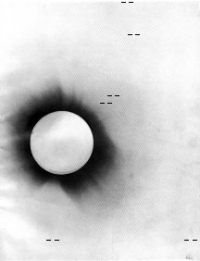 |
|
Figure 1. Principe Island, 29 May 1919. Marked on a negative photo of the 1919 solar eclipse are the positions of stars examined in the historic test of Einstein's theory of gravity (from Memoirs of the Royal Astronomical Society LXII, Appendix Plate 1). Enquiries about reproducing this and related totality images should be addressed to the Library of the Royal Astronomical Society, London. Image courtesy of the Royal Astronomical Society |
The announcement of favourable results in London on 8 November 1919 signalled the replacement of Newton's theory of gravity by the theory of general relativity. Its inventor, a 40-year-old Berliner called Albert Einstein, at once became the most famous scientist in the world. Expeditions of astronomers photographed the eclipse in difficult tropical conditions in Brazil and on the African island of Principe. At the time, the Sun was in front of a useful cluster of stars, the Hyades. The astronomers compared the relative positions in the sky near the Sun with the positions of the same stars as previously photographed in the night sky. The expeditions and analyses, organized by the Royal Society and the Royal Astronomical Society, were masterminded by Arthur Eddington of Cambridge. He was one of the very few experts who immediately understood Einstein's theory and appreciated its revolutionary importance, if it was correct.
Even for stars almost in line with the Sun, the shift in apparent position is less than 2 seconds of arc, or a few ten-thousandths of a degree. The 1919 measurements confirmed that the Sun bent the light rays by roughly the right extent - less than predicted in Principe, more than predicted in Brazil. After half a century of similar eclipse observations of the shifting stars, critics still said that there could be a 20 per cent error in the results. They were not accurate enough to rule out newer theories of gravity that challenged Einstein's version. Radio astronomers did somewhat better, with Quasar 3C279 which passes behind the Sun on 8 October every year. ESA's Hipparcos satellite (1989-93) provided the emphatic confirmation of Einstein's prediction. Hipparcos charted the positions of stars so accurately that no eclipse was needed to see the effect of the Sun's gravity. Where previous observations of the shifts had been confined to objects seen within a degree or two of the edge of the Sun, where the effect is strongest, the European satellite sensed the bending of light-rays even from stars in the night sky, at right angles to the Sun. According to the Hipparcos scientists, Einstein's prediction is correct to within one part in a thousand.
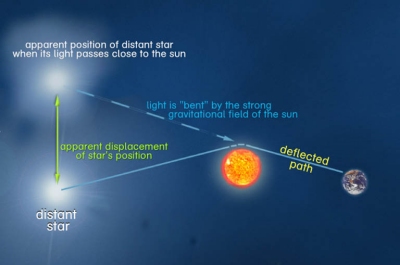 |
|
Figure 2. Illustration of gravitational bending - light from a star is bent by the strong gravitational field of the Sun. The effect of this is that the star appears to be in a different position. |
Related link: The Royal Astronomical Society
